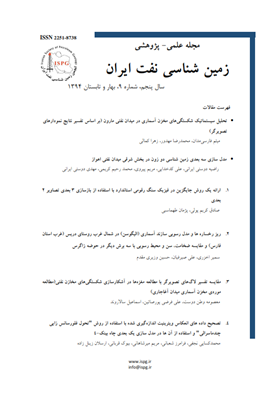ارائه يک روش جايگزين در فيزيک سنگ رقومي استاندارد با استفاده از بازسازي 3بعدي تصاوير 2بعدي
محورهای موضوعی :صادق کریم پولی 1 , پژمان طهماسبی 2
1 - دانشگاه زنجان
2 - دانشگاه تگزاس
کلید واژه: فيزيک سنگ رقومي بازسازي 3بعدي CCSIM ماسه سنگ بِرا ,
چکیده مقاله :
فيزيک سنگ رقومي روشي نوين است که براساس آن ويژگي هاي فيزيکي سنگ مانند تراوايي، ضرايب الاستيک و فاکتور سازند به صورت عددي و با استفاده از يک تصوير 3 بعدي از يک نمونه سنگ محاسبه مي شود. اين تصاوير توسط ميکرو-سي-تي اسکنرهاي پيشرفته تهيه مي شوند. عدم دسترسي به اين دستگاه ها و نيز زمان بر بودن چنين داده هاي پرهزينه و گراني، اهميت توسعه روش هاي جايگزين را به شدت نشان مي دهد. پيشرفت هاي اخير در بازسازي 3بعدي تصاوير 2بعدي مانند الگوريتم بازسازي CCSIM امکان ارائه چنين روش هايي را فراهم آورده است. در اين مطالعه، يک روش جايگزين به صورت زير ارائه مي شود: 1. تهيه تصوير 2بعدي با بزرگنمايي بالا، 2. تقسيم تصوير به زيرتصويرهاي مختلف، 3. بازسازي 3بعدي زيرنمونه ها، 4. تفکيک فازهاي کاني و تخلخل از يکديگر و 5. محاسبه پارامترهاي فيزيکي سنگ. اين روش روي داده هاي استاندارد ماسه سنگ بِرا پياده سازي شد. محاسبه نتايج ضرايب الاستيک و تراوايي از يک طرف، از روندهاي مرجع سنگ پيروي کرده و از طرف ديگر، تا حدود زيادي مطابق با نتايج مطالعات قبلي هستند. اين امر حاکي از دقت و کارايي مناسب روش پيشنهادي است. وجود دو روند متفاوت در محاسبات اوليه تراوايي اين نمونه ناشي از وجود دو نوع متفاوت از تخلخل و اندازه گلوگاهي تشخيص داده شد که با تغيير اندازه تصوير و انتخاب زيرتصويرهاي معرف تر اين مشکل رفع شد.
Digital Rock Physics (DRP) is a newly developed method to numerically compute rock physical properties such as permeability, elastic moduli and formation factor using highresolution 3D images of rock sample. These images are acquired using high technology µCTscanners which are not widely available. Imaging by this technique is also expensive and time consuming. However, improvement of 3D reconstruction algorithms such as CCSIM reconstruction method made it possible to be used effectively as an alternative strategy in DRP. In this paper, we propose an alternative procedure described as follow: 1. highresolution 2D imaging, 2. dividing the image to some sub-images, 3. 3D reconstructing of subsamples, 4. segmentation of porosity and mineral phases and, 5. computing of rock physical parameters. This method was implemented Berea sandstone formation. Obtained results show that, in one hand, average values of sub-samples properties follow a consistent trend with the reference trends of the rock sample. On the other hand, these trends pass the results presented by a previous work. Permeability results, however, show bi-trending. Investigation in sub-images revealed that there are two types of pore shape and pore throat size. To overcome this problem, 2D image were resampled and more representative subimages were generated. According to these results, it can be concluded that this is a valid method where an alternative method for standard
